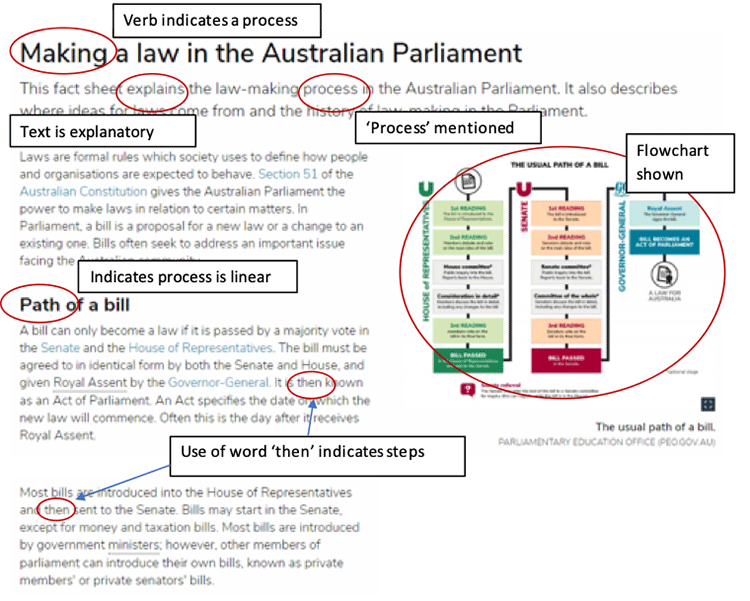Many texts that students read, particularly about Government and Democracy and Laws and Citizens, will be expository in nature. Expository text tends to use specific structures to communicate and explain information (Burke, 2000). According to RAND Reading Study Group (2002), students are more likely to learn concepts within the text if they understand:
- the idea of text structure
- how to analyse the text
Some common structures in Civics and Citizenship include:
- definition with example
- description of function/features
- compare and contrast two or more concepts or ideas
- cause and effect
- sequential process.
Explicitly teaching students how to recognise these structures in a text and identify key information within the text will support students to develop their Civics and Citizenship understanding.
One strategy to support students to read and respond to different expository text structures is text cue words and visual organisers.
Text cue words and visual organisers
Preparation: Text cue words and visual organisers
- Select a text that shows a particular text structure (e.g. compare and contrast). The text might be from a website, textbook, organisational fact sheet, or elsewhere.
- Select an appropriate visual organiser for students to record their understanding of the text structure that has been chosen (e.g. for compare and contrast, you might select a Venn diagram). A range of visual organisers are in the
Text Cues handout
- Prepare copies of the text, a template of the relevant visual organiser and text cue words (if modelling this strategy for the first time with the class).
Understanding the strategy
Provide students with a text that they will read. Draw students' attention to key text features by posing prompting questions for each feature:
Heading/sub-headings:
Prompt questions:
- What does the heading/sub-headings say?
- In no more than 2 sentences, explain what you think you will learn about from this article/textbook page/web page/etc.'
Rationale:
- This is to draw out student responses about what they believe the purpose of the text is.
Highlighted text (e.g. bolded, underlined, italicised text):
Prompt questions:
- Give an example of the text that you can see that is bolded/underlined/italicised.
- Why do you think this text has been highlighted in this way?
Rationale:
- This is to focus student attention on key information in the text that might help them to identify the particular text structure.
Images:
Prompt questions:
- What images can you see in the text?
- What type of images are they (e.g. diagram, cartoon, photograph, table)?
- Why do you think the author has chosen this type of image?
- What is the image showing you?
Rationale:
- As with highlighted text, this is to focus student attention on key information in the text that might help them to identify the particular text structure.
- Provide students with a
Text Cues handout
-
If modelling the strategy for the first time, you might provide students with a completed
Text Cues handout, and explicitly teach the examples of words and images associated with different text structures [HITS Strategy 4].
- If students are familiar with text cues, teachers might provide them with a
Text Cues template.
- Instruct students to use the Text Cues handout to work out which text structure they believe the text represents. Students can be asked to work individually or in pairs
[HITS Strategy 5].
- Ask students to justify their response by providing examples of text cues that they have found in the assigned text.
- Instruct students to
annotate the text, as per the example below.
For example, a sequential process text type.

Source:
Parliamentary Education Office (n.d.). Making a law in the Australian Parliament.
- Students share their responses as a class.
- If the text that has been assigned to students does not include an example of an image as a text cue, instruct students to use the written text to create a visual representation of their civic and citizenship understanding of the focus concept (e.g. If the flowchart was not provided in the example of how to pass a bill in Australia's parliament, students could be asked to construct one).
- Alternatively, if the text does include both written text and images, instruct students to write a summary of the assigned text and/or image to demonstrate their civic and citizenship understanding of the focus concept.
Link to the curriculum:
VCCCL023